Out of all the returning characters in Twin Peaks, The Return, Sarah Palmer might be the one whose life turned out to be the harshest and most cruel. Thinking about how her life was back in the original run of Twin Peaks, it really wasn’t even close to good then, either.
SARAH PALMER IN THE ORIGINAL RUN
We first see Sarah in the pilot where she’s standing in the kitchen. She’s showing no other negative feelings than annoyance at the time – her daughter just can’t seem to get out of bed to make it to school in time that morning. She calls out for Laura, chain-smoking as always, expressing her impatience over the situation with a sigh. Right there, for just a moment, Sarah Palmer seems pretty ok. Reasonably normal. Like any parent to a teenage girl who takes just a little too much time to get ready for school.
But it all soon changes. Quickly it becomes clear that tragedy has struck the Palmer family. Sarah’s daughter is not sleeping in, she’s missing from her bedroom. Just a few phone calls later, and Laura goes from being missing to dead. Murdered. This realization is forever symbolized by Sarah’s horrifying scream. It’s her first scream of Twin Peaks, but it’s not her last.
The scream changed everything. From that moment on, Sarah’s whole demeanour turned into a tragic personification of grief and deep despair. With very few exceptions, everything we see of Sarah Palmer in the first two seasons was a broken, devastated mother burdened by an enormous loss. And still, everything only went downhill from there.
“Today I bury my husband next to my only child. Her grave is still so new. There’s only a little bit of grass on it.”
(Sarah Palmer before Leland’s funeral, season 2, episode 10)
Fire Walk With Me changed our perception of what really went on in the Palmer house. And quite dramatically so. The movie portraits Leland Palmer as being much more conscious about the criminal and terrible acts that BOB “made” him do, than was ever suggested during seasons 1-2. The series shows a father possessed by an evil entity that somehow “switches off” Leland’s consciousness when he’s taking charge of his “vessel” (to use a MIKE phrase). In Fire Walk With Me we’re told a different story. Here, Leland is much less sympathetic, much less of a victim who doesn’t know what’s happening whenever BOB’s taking over. In Fire Walk With Me, Leland is the abuser.
“This is the water and this is the well. Drink full and descend. The horse is the white of the eyes and dark within.”
(The Woodsman, Twin Peaks, The Return, part 8. Leland, Sarah and the white horse, Fire Walk With Me)
I’ve always thought of Leland – not BOB – as the murderer of Teresa Banks. Leland called Teresa to arrange sexual meetings after finding her in Flesh World Magazine. Not BOB. Leland knew about his actions and that they were a betrayal of his wife Sarah. He found out that his own daughter Laura was involved, and that she too was prostituting herself. Leland– not BOB – eventually murdered Teresa to prevent her from blackmailing him. Being exposed for buying sex from teenage girls threatened his career, his marriage, the relation to his family and quite possibly his freedom. Leland’s reputation was in danger – not BOB’s.
“Teresa Banks… You look just like my Laura.”
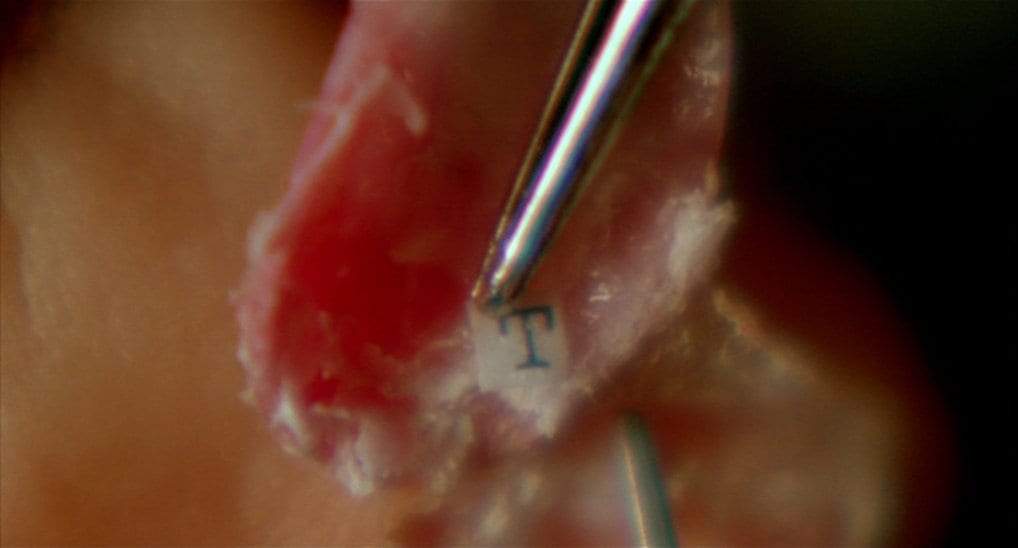
(Leland Palmer reading Fleshworld. Teresa’s left ring fingernail, Fire Walk With Me.)
Fire Walk With Me ends just before season 1 starts – with the murder of Laura Palmer. The movie shows her killer shape-shifting between Leland and BOB. Whether Leland was completely unaware of his actions or not during this murder can be debated, but as I see it, BOB was clearly in charge in that train car.
With Fire Walk With Me, the trouble that already surrounded Sarah Palmer before her daughter’s murder becomes very clear. This wasn’t a “reasonably normal” family by any means. The father solicited sex from girls of his daughter’s age. The marriage was seemingly unpassionate, even abusive. Leland (and/or BOB) drugged Sarah in order to keep her from knowing about his incestual acts towards their daughter. And Laura was herself deeply troubled by a lifestyle of drug abuse, secret love affairs, prostitution and the terrible knowledge that BOB could show up to abuse her at any time.
Laura Palmer was drawn to the fire as if she was possessed by a need to confront and defeat her abuser. She put the Ring on her left ring finger in the train car, and as a consequence, she was murdered instead of surrendering to BOB. She wouldn’t let BOB possess her, but with that decision, she paid with her life.
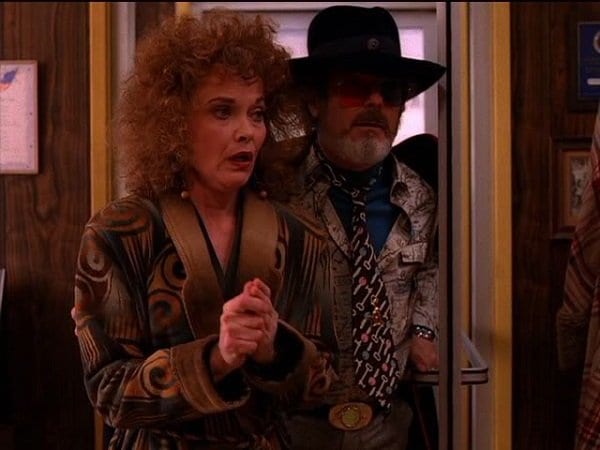
And that’s where we left off for a long time. Then came Twin Peaks: The Return. Like Twin Peaks, Sarah Palmer returned back to us. Some 25 years had passed since we last saw her channelling a cryptic message to Major Briggs at the RR Diner in the very last episode of season 2. Sarah was always spiritually gifted. But when she returned this year, it became clear that she might also be damned.
GIFTED AND DAMNED – SARAH 25 YEARS LATER
As soon as we reenter Sarah’s life in The Return, we know something’s very wrong. To put it simply: she’s a wreck. Her lonely life of watching strange TV programs, a Bloody Mary based alcoholism and the even heavier chain-smoking than ever before – this is now Sarah Palmer’s reality. Whenever she interacts with people they either think she’s a really weird old lady (as at the grocery store) or they don’t seem to understand her, even if they have politely good intentions (as when Sarah’s visited by Hawk). But, as I’m sure many of you also did, I found the removal-of-her-face scene at the Elk Point’s #9 Bar (part 14) to be her most troublesome one thus far. You know the scene I’m talking about. Everyone does. But the interpretations of what the heck happens in that scene vary.
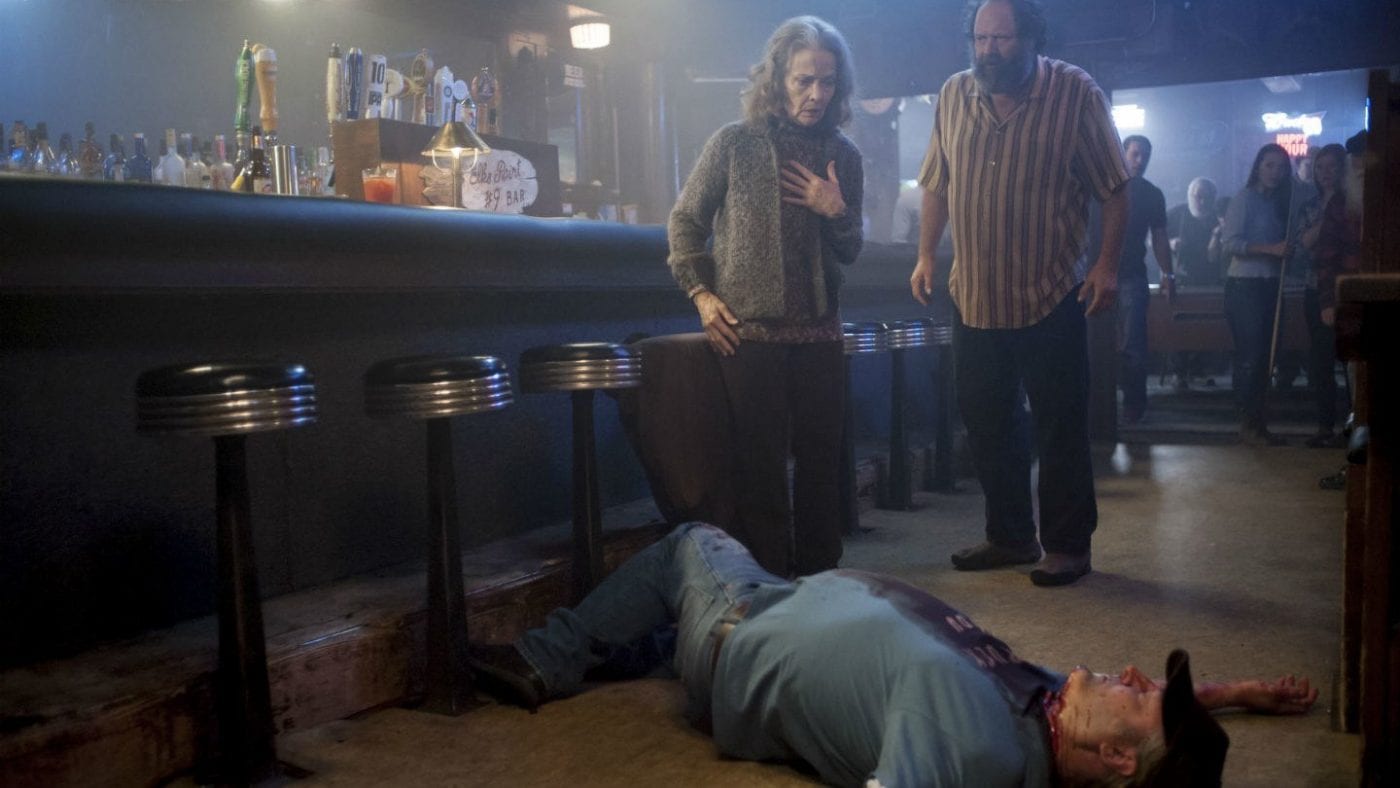
Back in the end of August this year I wrote an article about the Black Fire as being the reason so many inhabitants of Twin Peaks seem to be physically and/or spiritually ill. As a part of my thinking back then, Sarah Palmer’s descent into darkness over the last 25 years had to do with her spiritual mound having been weakened by grief.
“The spiritual mound, the left ring finger, is blackened. It also appears to be larger than normal, like it’s swollen. The spiritual mound that we see is affected by some kind of sickness. Can this be an indication that Sarah’s defense against bad spiritual influence has been affected, broken down or even destroyed? Is that what is wrong with Sarah Palmer?”
(From Black as fire – Twin Peaks is diseased and war is coming.)
The breakdown of Sarah’s defence allowed the Black Fire to somehow get to Sarah, turning her gifted spirituality and psychic powers into damnation. In other words; dark and evil influences have taken over and transformed her into the Sarah we see in The Return. Once she was gifted – now she’s one of the damned.
“This is his true face, but few can see it – the gifted, and the damned.”
(MIKE about BOB, season 2, episode 6.)
Or could it be that what Sarah did at the bar was showing her own true face to a damned man? Many have concluded that Sarah is evil, Judy, Mother or all of them. I don’t know, but I definitely don’t think I agree at all. And I’ve done a lot of thinking lately.
HIBERNATION
Since I published my Black Fire theory back in late August, all of the remaining parts of The Return have aired. Mark Frost’s The Final Dossier has been released. In fact, that was already a while ago now. After the finale had aired, I found myself withdrawing from Twin Peaks. I was “hibernating”, like Major Briggs, in a Zone where I only had myself, my thoughts and my processing of everything I’ve seen. I haven’t been keeping up with other people’s theories or thoughts during hibernation. I needed this active but distant state for as long as it would take. But never a day went by without me thinking about Twin Peaks, The Return and everything around it – high and low. It’s taken me this time to literally begin to settle into what I’ve seen. To find my own coordinates, if you will.
Finally, I’m ready to put some of my thoughts on print. And my thoughts are often with Sarah Palmer. I will now present a somewhat different reading of Sarah’s persona and her actions, as well as placing her in part in an alternative timeline.
THE EVOLUTION OF TIME
We’ve been served dramatic changes in narratives in The Return, some of which were established 25+ years ago and considered hard “truths” written in stone ever since. It has all been more than a mouthful of brainf*ckery to swallow. I mean this in a good way, even though in many ways I’m more confused than I’ve ever been. I knew we weren’t going to get clear and logical answers, and I’m glad we didn’t. But never had I imagined just how brilliantly Frost and Lynch managed to turn established, solids truths of stone into a floating mass that could seep into and change the stories that we’d taken for granted for a long, long time.
When Cooper goes back in time in his attempt to save Laura from being killed, he managed most of all to screw things up. You cannot change one thing alone about history without creating a butterfly effect. The past dictates the future. But Laura Palmer did not die. How about that for something almost unfathomable to grasp, understand, process and get used to?
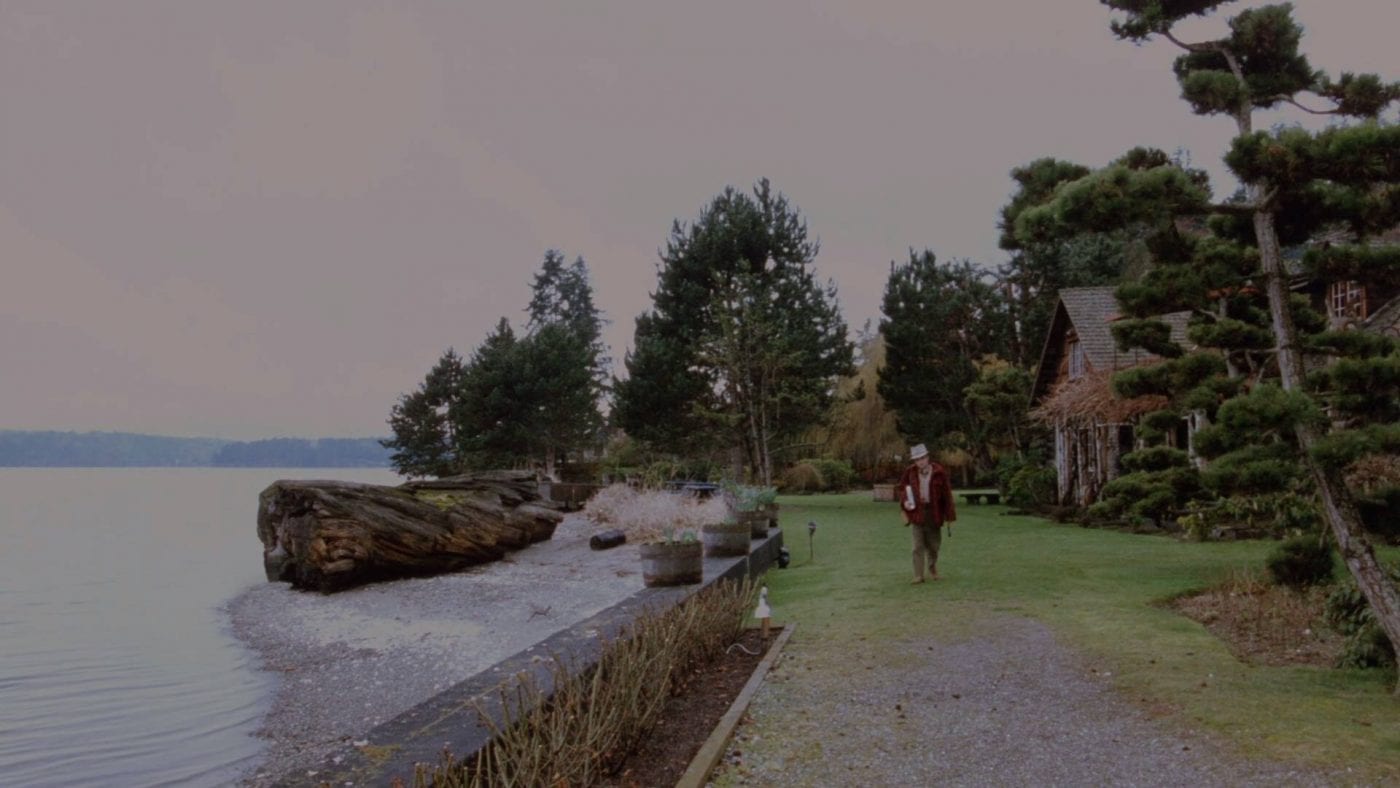
(Pete Martell – no body of Laura Palmer, Twin Peaks, The Return finale.)
With The Final Dossier, we learned a few new things about Sarah. Yes, the young girl in New Mexico in 1956 was indeed her. Hers was the mouth that the moth-frog climbed into. Agent Preston also confirmed what we already had understood: Sarah’s life turned to alcoholism, isolation and depression. But when Cooper went back in time and changed the future, Sarah’s daughter’s status changed from “murdered” to “missing”. As a consequence, Sarah’s feelings towards the loss of her daughter are arguably rooted in the pain of not knowing what happened to her – and therefore, Sarah is unable to get any closure. In addition to this, The Final Dossier tells us that Leland committed suicide one year after Laura’s disappearance. In other words – in this new timeline of events that Cooper caused, Leland is still dead, but the manner of his death seems to me to be possibly even more tragic in many ways.
(“Find Laura.” Leland Palmer in Twin Peaks, The Return, part 2 and 18.)
SOME KIND OF CLOSURE
Leland’s suicide leads me to assume that he was going through hell and found himself unable to cope with it. The abuse of Laura and the suffering he just might have known he’d caused her would have added a tremendous amount of guilt onto his shoulders as well. When he ended his own suffering Sarah was the last Palmer standing. Only this time, in the new version of events, one can only imagine how absolutely devastating the situation would be for Sarah to handle – to our knowledge pretty much on her own.
Sure, Agent Preston does say Sarah “was treated”. But I personally don’t believe that she’d be able to reach the relative comfort that she after all found during season 2. Back then, at least Sarah found out somewhat what had happened, and it was Agent Cooper who helped her reach that state:
“Mrs. Palmer, there are things dark and heinous in this world. Things too horrible to tell our children. Your husband fell victim to one of these long ago, when he was innocent and trusting. Leland did not do these things. Not the Leland that you knew.”
“No. That man I saw. Long, dirty, disgusting hair.”
“He’s gone. Forever.”
“So is everything I loved.”
“Sarah, I think it might help to tell you what happened just before Leland died. It’s hard to realize here … and here … what has transpired. Your husband went so far as to drug you to keep his actions secret. But before he died, Leland confronted the horror of what he’d done to Laura and agonized over the pain he’d caused you. Leland died at peace. In his last moments, he saw Laura. He kept saying how much he loved her, and I believe she welcomed him. That she forgave him.”
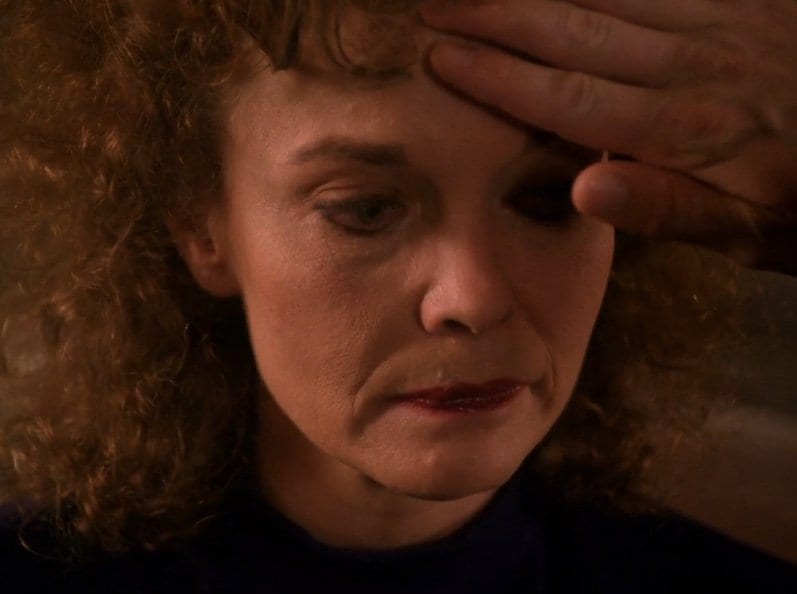
Even if the things that Agent Cooper tells Sarah in season 2 are absolutely horrible, they are honest and well meant. (And somewhat true – only the parts of Leland’s innocence of his actions while possessed by BOB, and that BOB was “gone forever” are debatable. I believe Cooper tried to spare Sarah of the worst in order to help her move on). Judging from her response to Cooper’s account of Leland finding some peace before passing away, Sarah finds some kind of immediate relief despite all of the horror, sadness and loss. I believe that Cooper’s words, as unimaginably hard they might seem to process, would be helpful and somehow constructive to Sarah’s grieving process in the long run. Sarah even smiles a smile of relief when hearing about Leland and Laura making peace. She’s able to find some kind of closure.
But with Cooper travelling back in time to save Laura, the narrative changed and the timelines shifted. Cooper tried to change the past without realizing just how much it would dictate the future. In the finale of The Return, not only “somethings” changed (as Cooper said they would in part 17). A lot of things changed to become very, yrev different.
RETURNING TO THE BAR SCENE
I’ve thought a lot about the Elk Point’s #9 bar scene, and since I read The Final Dossier a new thought was taking form. When did this scene actually occur? In which timeline? In what version of events? Agent Preston only writes a short paragraph about the incident in the dossier:
“Oh, and in the past year, right around the time Cooper disappeared again and time took a vacation, [Sarah] was named and questioned as an eyewittness to a particulary gruesome and mysterious death in a disreputable Twin Peaks dive, where a man on the barstool next to her dropped dead with most of his neck missing.”
(Mark Frost, The Final Dossier, p. 137.)
THE BAR SCENE – THE ALTERNATIVE TIMELINE
So, the incident when Sarah removes her face followed by the gruesome attack on the misogynic “Truck You”-dude in the bar happened “right around the time Cooper disappeared”. That’s all we know. It, therefore, seems that it’s unclear whether the bar scene happened before or after the events in part 18. And so, I will now ask you to follow me along on a shift of time. I will ask you to place the bar scene in the timeline where Laura Palmer is considered missing, not murdered. The Sarah Palmer that walks in to order a Bloody Mary that night is now the widow of a man who comitted suicide some 24 years ago. She is the mother of a girl who’s been missing without a trace for the last 25 years.
With this new approach to Sarah Palmer and her situation during the events at the bar, let us recap what’s seen within her face after she removes it:
1. THE ENTITY. We first see what looks to me like the head of the Experiment Model spitting out two icicle-like forms. Many have said the latter resemble either…

…A: the long, pointed nose of the Jumping Man (whose face is overlapped with Sarah’s in part 15).
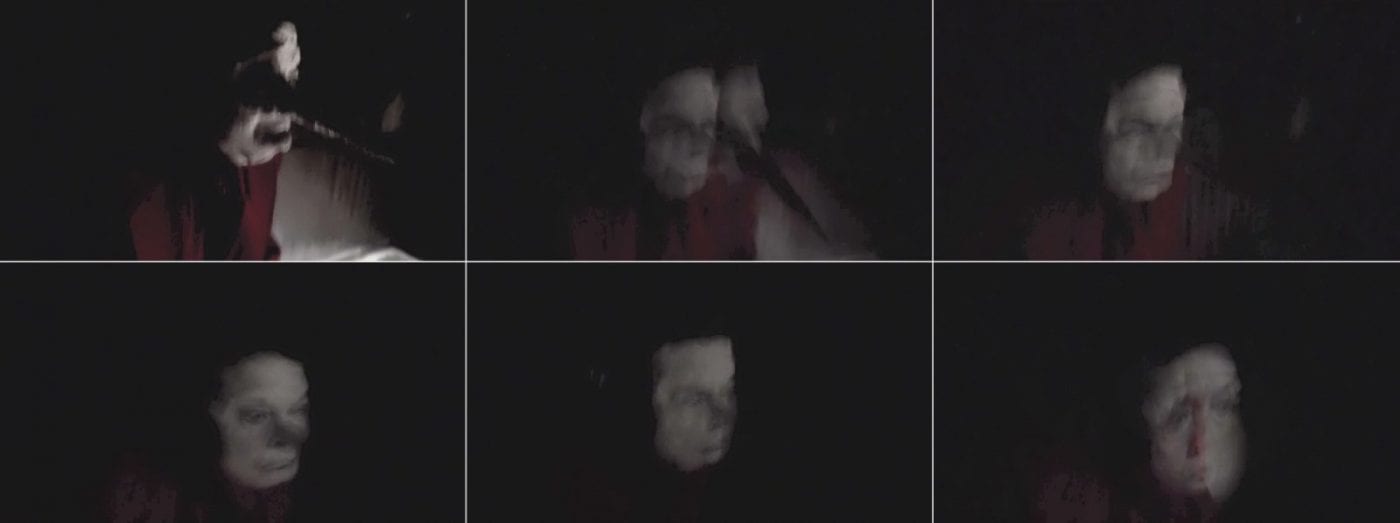
...or B: the antenna on front of the moth-frog’s head (especially after it was confirmed that the 1956 New Mexico girl indeed was the young Sarah Palmer).
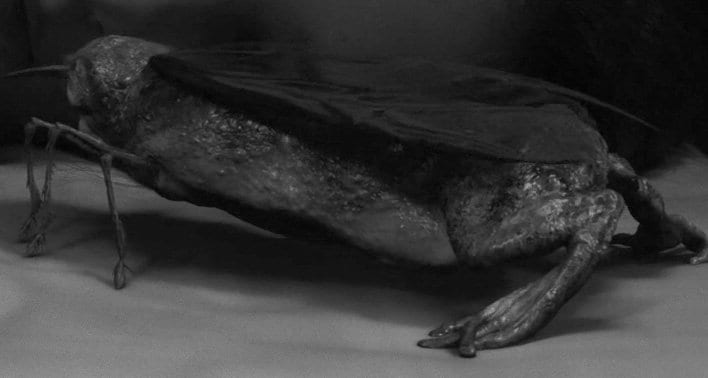
Take a listen to the sound that the icicle-like shapes make while exiting Sarah’s face. It reminds me of the metallic stabbing noise that can be heard in several other scenes in The Return. When the Experiment Model kills Sam and Tracey in New York, the sound is there. It can be heard when Naido is warning Cooper not to exit the number 15 electrical socket. And the sounds we hear while Sarah is stabbing her daughter’s photo are also similar to the “icicle-sounds” (I’ll come back to this scene later).
2. THE HAND. The hand was the one thing that stood out to me the most upon my first viewing of part 14, because I immediately recognized it from the train car murder scene of Fire Walk With Me. This is Laura Palmer’s hand, and that is very significant, especially in this reading. This is no less than a flashback to one of the most important scenes in Twin Peaks. Ever. This is the moment when Laura makes the biggest decision of her life: to put the Ring on her left ring finger. She knows that by doing so BOB will have to kill her, but he won’t be able to possess her as he wanted to do.
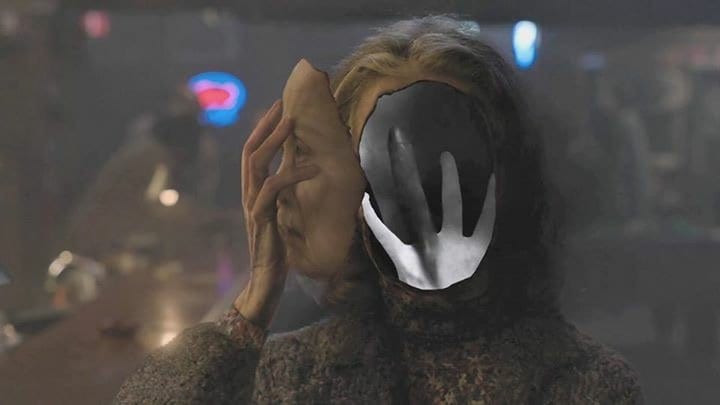
The fact that Laura’s hand is seen here without the Ring is absolutely crucial. The bar scene takes place after Agent Cooper’s second disappearance – he has already gone back in time to prevent Laura’s murder. Therefore, Laura never died. Laura disappeared. Laura never wore the Ring in the train car. This is why we don’t see it on Laura’s spiritual mound. But, as I hinted at in my previous article, it also means that the spiritual mound is severely damaged and affected by the Black Fire, making Laura and/or Sarah vulnerable to evil spiritual influences.
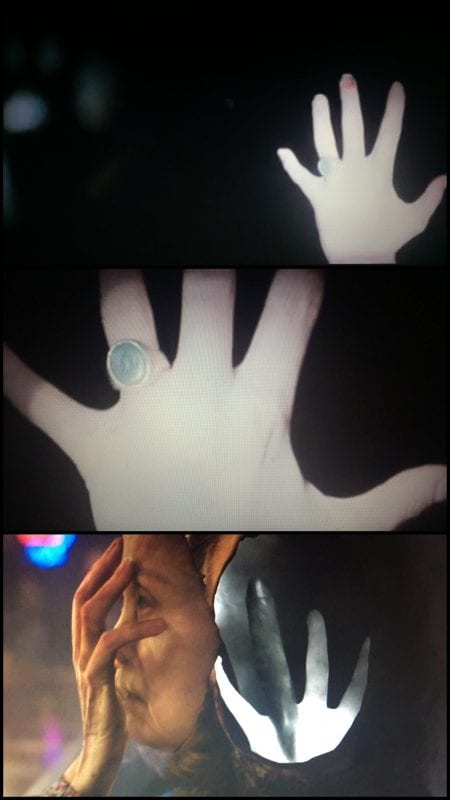
An interesting note worth mentioning – this scene from Fire Walk With Me:
“You didn’t wash your hands before
you sat down for dinner did you? Let me see.”“Dad…”
“Your hands are filthy… look, there
is dirt way under this fingernail.”
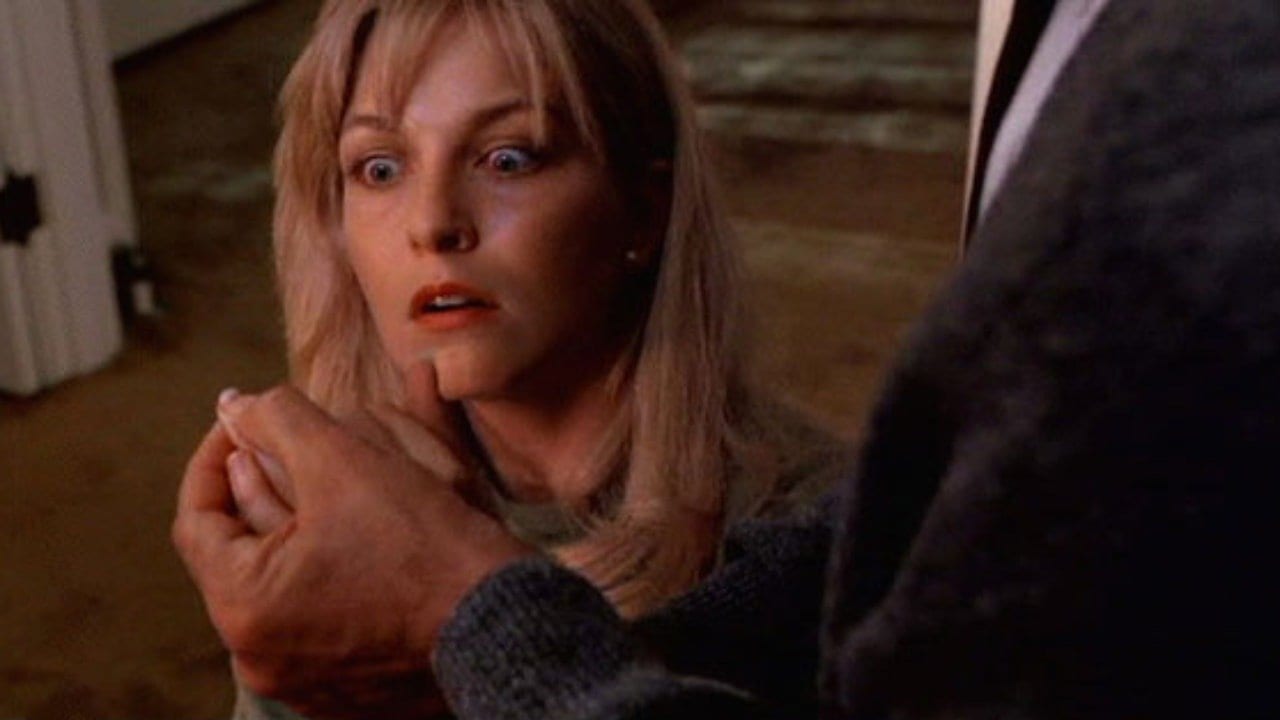 (Leland and Laura Palmer, Fire Walk With Me.)
(Leland and Laura Palmer, Fire Walk With Me.)
3. THE SMILE. Surrounded by the dark smoke of the Black Fire, there it is: a beautiful smile turned twisted and wicked by its new context. I say new because we’ve seen this particular smile before. It’s Laura’s.
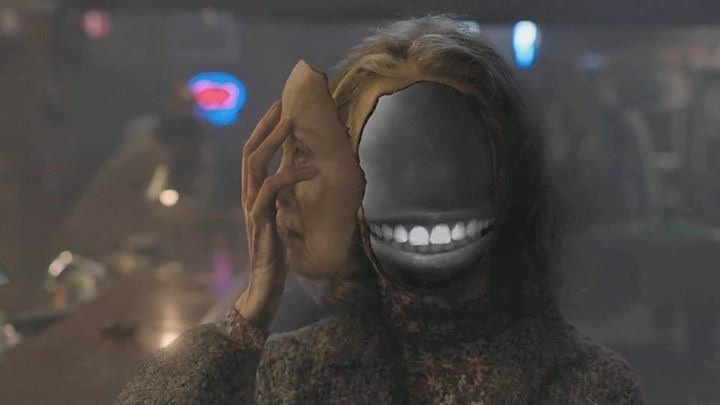
It seems pretty clear that the smile inside of Sarah Palmer is the same smile what we’ve seen on Laura’s prom photo so many times. Again, a part of Laura is revealed when Sarah removes her face at the bar.

Let’s contemplate the significance of the smile in relation to the hand. If the hand of Laura represents a very traumatic and important moment in Laura’s life – the one moment that will dictate her fate in a very serious way – the image of her smile, on the other hand, represents the seemingly successful, desirable and innocent Laura Palmer. The girl on the prom queen photo is the Laura Palmer most people of Twin Peaks thought they knew before all the secrets that she was filled with leaked out. Before she was either murdered or disappeared.
“Sheriff, we have to be very carefully remove this key. I’m gonna run this envelope. And my bet is it’ll test positive for cocaine.”
“That’s impossible.”
“You ever been surprised before?”
“Mr. Cooper, you didn’t know Laura Palmer.”
“Let’s get started on a court order to open that safety deposit box and maybe we’ll both find out a few things about Laura Palmer.”
(Conversation between Sheriff Harry Truman and Agent Cooper, Season 1, the pilot.)
In any case and timeline, the smiling girl in the photograph represents a time when Sarah had no reason to think that anything could be so completely wrong as it later turned out to be. Laura’s smile represents easier, happier times. Sarah’s past with her family, a sense of belonging, a life without solitude and of much fewer problems.
4. BLACK FIRE. Throughout the whole removal-of-the-face-sequence, black smoke is present. This is the sign of the Black Fire’s influence on Sarah Palmer in general, as I’ve previously written about. The Black Fire – death – surrounds her, has long ago filled her with darkness. Her “dark within” is her inability to make peace with her situation.
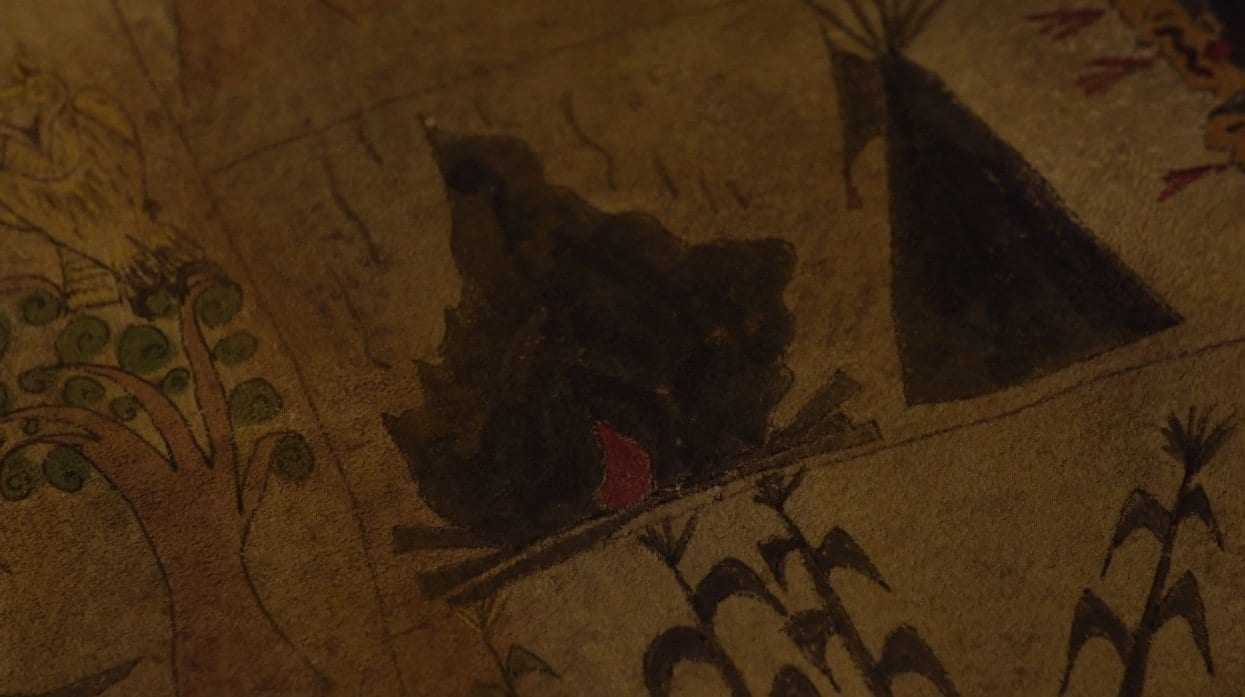
SYMBOLIC IMAGERY
The visual elements lead me to draw further conclusions about what Sarah Palmer choose to show the misogynic “Truck You”-dude at the bar before killing him:
SORROW AND LOSS. Laura’s prom queen photo represents the prime time of Sarah’s life and a mother’s pride at the time. In Sarah’s mind, the picture is the strongest symbol of the easier life she once had, now but a dark shadow from her past. It’s a mere recollection that has since turned into bitterness and depression. Sarah’s lack of closure makes it impossible for her to focus on cherishing a past of happier memories and better times. Just as Hawk once said about facing a spiritual challenge: Doing so “with imperfect courage, it will utterly annihilate your soul”. In a world where “fear and love open the doors”, Sarah’s mournful state has made her succumb to fear over the many years that she has spent alone entangled in her chaos.
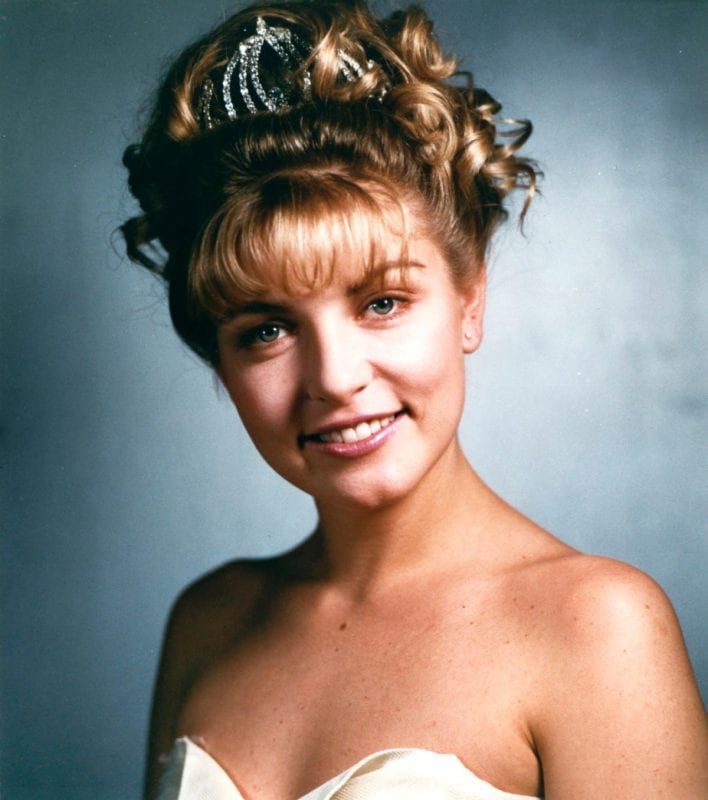
UNCERTAINTY AND FRUSTRATION. Laura’s hand isn’t wearing the Ring, and so Laura is a missing girl. Without the closure that comes from knowing what happened to her daughter (no matter how horrible the truth might be), Sarah finds no comfort, she’s got no grave to visit. Left to carry the unfathomable burden of not understanding or knowing the circumstances of Laura’s whereabouts or fate, she’s all alone with her grief.
Being a true-crime freak, I’ve seen I-don’t-even-know-how-many documentaries of missing persons. Family members of the missing are lost in the land of limbo between hope and despair. This state of constant torment has only one or two ways out: finally learning what happened to your missing loved one, or choosing to end your own life, thus the suffering. Leland Palmer chose the latter long ago, but Sarah is desperately and stubbornly stuck in limbo-land. There’s no closure for anyone – especially not for Sarah. She carries her loss, grief, uncertainty and frustration with her wherever she goes. Thinking about it almost makes me surprised that Sarah didn’t turn out ever more broken than she is. In a way, you might say it makes her strong, but the strength is quite destructive.
SPIRITUAL INFLUENCE. It cannot be denied – there’s more to Sarah Palmer than her own feelings about how her life has turned out. Influences of outside, dark spiritual forces are there, too. I’ve already scraped the surface of what conclusions could be drawn from the visual references to the Jumping Man, the moth-frog, the Experiment Model and the sounds. What to make of it all, however, is beyond this particular article for now. However, I think it’s fair to say that we know this much:
A: Sarah Palmer swallowed the moth-frog in 1956. B: The moth-frog seems to have hatched from an egg that originated from the Experiment – an entity that in turn seems related to the Experiment Model that appeared in the New York glass box. C: The moth-frog egg(s) was/were brought into the world at the same occasion as the “BOB orb”. (I’m personally not convinced that BOB originated from the Experiment – I’ve argued before that he didn’t.)

D: The glass box was set up by Agent Cooper’s doppelgänger, Mr. C. E: Mr. C is clearly connected to BOB, both spiritually and physically. (Whether Mr. C is possessed by BOB, is possessing BOB or in symbiosis with BOB is up for interpretation.) F: BOB used to possess Leland Palmer. This seems to be true regardless of which version of events and timeline we chose to adapt. Laura Palmer being missing or a murder victim – her father was BOB’s vehicle either way.
Everything is connected, therefore somehow very logical, yet not very clear. (And this might just be the essential beauty of Twin Peaks. It’s full of never-ending mysteries that will last a lifetime and beyond).
RETURNING TO THE SCREAM
There’s one more scene I’d like to try and place on the timeline of events where Laura Palmer is missing, not dead. I’d like you to go back with me to one of the most disturbing scenes of The Return. We’re in the Palmer house again. The living room is deserted at first, but we can hear terrifying sounds from another room. It’s Sarah. She’s moaning and grunting with sounds almost non-human, like something out of this world. (And in the light of things, it probably partly is). When Sarah enters the frame she’s agitated. She grabs Laura’s framed prom photograph, goes down on the floor, smashes a vodka bottle and starts to slash at the photo with the broken glass like she’s attacking something dangerous and bad.

“LISTEN TO THE SOUNDS”
If there’s anything we should keep in mind, I think it’s the words of The Fireman from part 1. “Listen to the sounds”, he tells Agent Cooper, almost as if it’s a warning or at least a firm but gentle urging. And so, when Sarah stabs the photo of Laura – the very symbol of her life she used to have – I listen to the sounds.
There are several recognizable sounds to notice. I’ve already pointed out the similarity to the “icicle-sounds”. There’s also the same electrical sounds that we also hear for example when Mr. C is driving to Twin Peaks and we see the electricity poles pass by (the same imagery that Andy witness when he’s visiting The Fireman). A pulsating noise that (in combination with the scene’s jagged, stop-motion like cutting) creates a feeling of chaos and time being out of order.
But most noticeable of all sounds are Sarah’s screams. It’s no coincidence – the screams are the same as way back in the pilot episode right from the moment that Sarah’s on the phone with Leland and realizes that Laura is dead. This is a moment that haunts Sarah, and her screams represent this haunting just as Laura’s prom smile represents the life that existed before tragedy struck. Listen and compare for yourself: Pilot scream – The Return, part 17 scream. It’s the same recording.
WHAT YEAR IS THIS?
So, why would I consider the possibility that this scene too could be a scene from the alternative timeline (where Laura’s missing, not dead)? First of all, why not? The timelines in Twin Peaks aren’t exactly perfectly established, as they might be in most other TV series that we know. But to refine this thought a little bit further: we don’t get to see Sarah’s face. It’s hard to tell her age just from this scene alone. The big flatscreen TV is there, but that really doesn’t help much. This could be a scene that takes place in chronological order – in other words: it plays out before Agent Cooper goes back in time to change history. But it might as well be a scene from a different timeline, thus portraying a mother lost in the grief and despair of not knowing what happened to her missing daughter. For all we know, this scene could be from years before.
Whenever this scene is taking place, it’s a depiction of Sarah’s breaking point or one of many recurring ones. She can’t take living in limbo anymore without knowing what happened to Laura, without someone there to provide her with comforting answers. The hopeless situation drives her to symbolically take out her feelings on the one person that has caused her overwhelmingly hopeless state – her daughter, Laura Palmer.
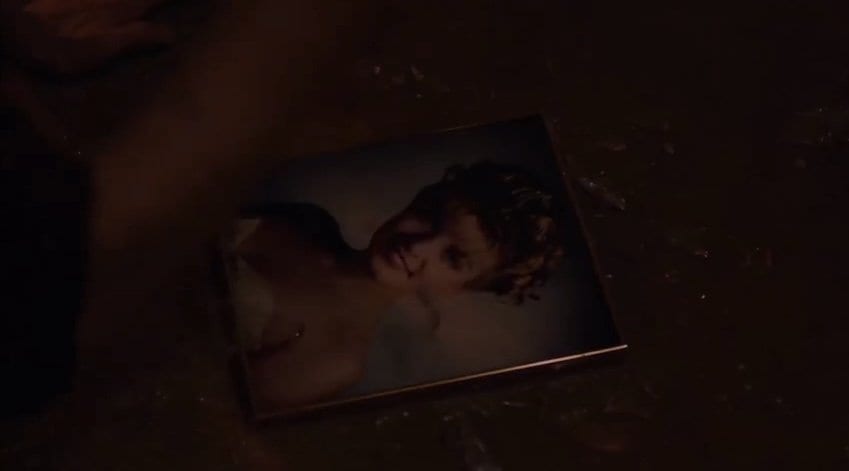
It doesn’t matter to Sarah that Laura’s absence cannot rationally be blamed on the missing person – there’s just nothing and no one else to blame. By hacking away at Laura’s photographic face, Sarah is projecting years of torment and feelings of abandonment onto her daughter. It’s not a rational act, it’s not even necessarily personal – but it’s her only way to release years of living in that limbo that exists between the reliefs of hope and despair. Everyone needs an outlet from time to time, and this is Sarah’s.
BEING EVIL, BEING HUMAN
This way of looking at Sarah Palmer and everything that’s been so weird and uncanny about her actions and demeanour during The Return makes me think of her as more genuinely human than evil or as an entity. I know many people have changed their views on Sarah during this year, and are now considering her to be more evil than we’ve known her to be in the past. However, I see a completely broken person filled with and consumed by grief, loss and a dense frustration. The fact that she clearly is influenced or even driven by outside spiritual forces is almost a side note when it comes to the traumas she has had to experience in her life. Anyone would be bent to their knees, mentally shattered and broken down completely after half of what Sarah has gone through.
It really doesn’t even matter on which timeline you chose to place above mentioned scenes with Sarah – she loses either way. Devastatingly bound to a life of confusion, loneliness and loss, Sarah is the number one lost soul of Twin Peaks. It’s a first prize no one wants to win.
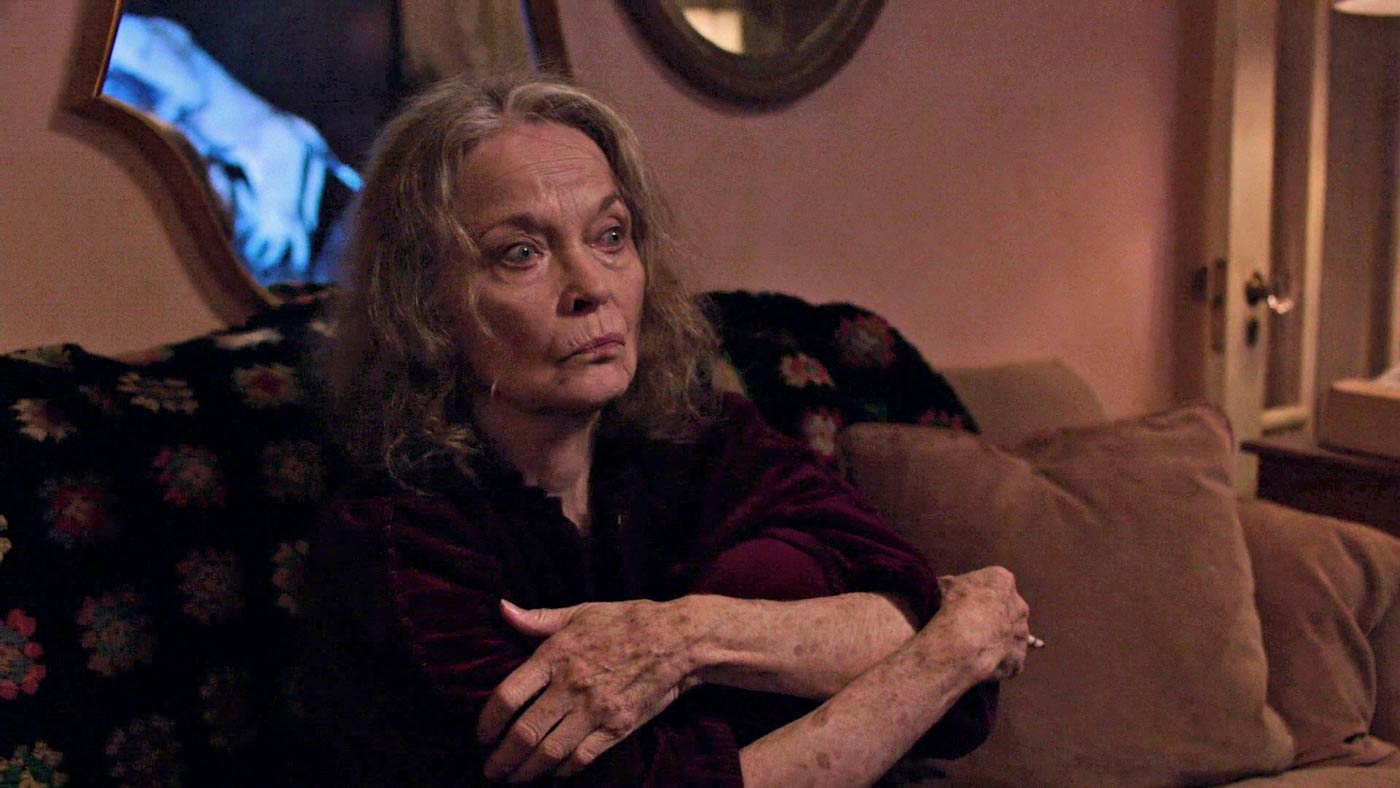
BACK TO STARTING POSITIONS
And so to conclude this piece on Sarah Palmer, I’d like you to go back again with me to Elk Point’s #9 Bar. Sarah’s trying to mind her own business (and we know that she’s got a lot to handle, regardless of the timeline). She orders her self-medication: a Bloody Mary. The lonely dude with the “Truck You” shirt comes over and is trying his “best” (which is not very good at all) to hook her up. It doesn’t work. But instead of leaving Sarah alone, the dude shows off his absolute worst side by proving to everyone who’s got a functioning brain that he’s one of those men who just won’t take no for an answer.
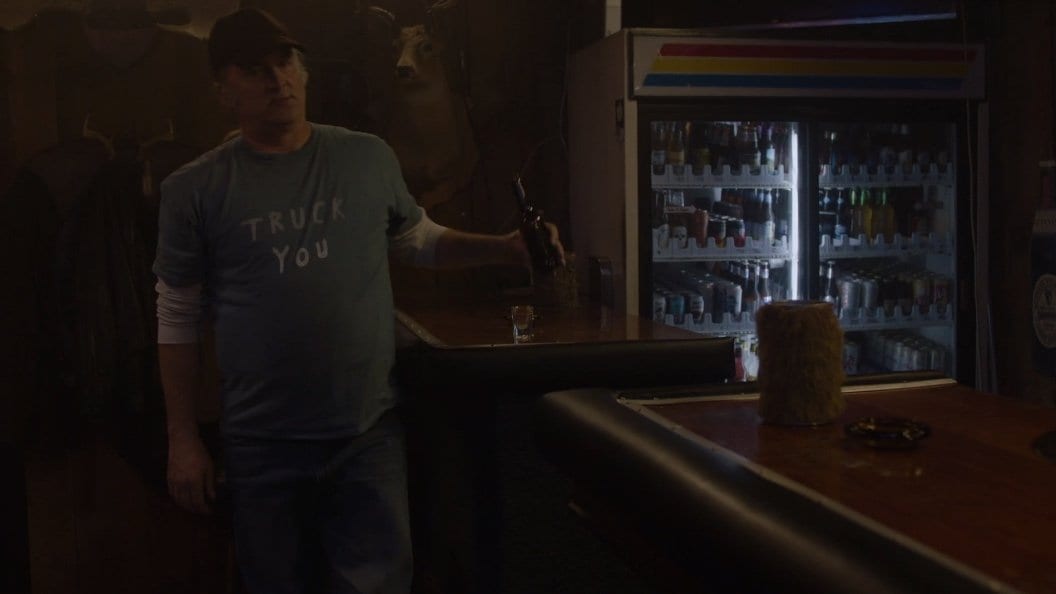
In fact, a “no” is his worst-case scenario, because it means he’s no longer in control. And just like Leo Johnson he needs to be in control, so he turns to plan B: Humiliation. After all, who does this woman think she is to reject him? She must be a “lesbo”. Right…
I’m sure that many, many of you identify with parts of this situation. Similar offenses (yes, it’s highly offensive) have happened to me and many of my friends too many times.
It really is a world of truck drivers.
Sarah will only take so much of verbal assault. We know what happens next: after removing her face to show the dude what she keeps inside of her, Sarah kills the man with a swift bite to the neck area. It’s a brutal and deadly attack, yet I found myself cheering “Hell yes” at my first watch. No, I don’t believe that anyone deserves to be killed, but this scumbag simply acted so degradingly and horrible towards Sarah that it made me hate him dearly. Sarah took out the ultimate, brutal revenge – and she did so in quite a surprising and unsuspected way that I think none of us saw coming.
“DO YOU REALLY WANT TO F*CK WITH THIS?”
But to back up one step – what message did Sarah deliver by showing the “Truck Me”-dude the images inside of her face while rhetorically asking him “Do you really want to f*ck with this?” What was this last warning all about? I believe it can be summarized something like this:
“Are you sure you want to mess with a woman filled with bitter and bottomless grief, despair and hopelessness? Have you got any idea how dark and diseased I am on the inside?
How dare you violate my completely shattered spirit and trespass the already limited space I’ve got left after years of anguish and loss? How dare you? Do you really want to f*ck with this?”
To be honest, “Truck You”-dude seems to have had it coming. Killing isn’t the right choice by any means, but Sarah is way beyond the moral questions of right or wrong. Sarah is consumed by her poisoned mind and perhaps influenced by spirits with their own agendas. She’s a victim of all the traumas of her miserable life. She’s been broken down for a long time by being hopelessly stuck in a bad circle of substance abuse, isolation and ever-repeating negative thoughts. Sarah Palmer is not a sane, healthy person. She’s a shadow of her former self, and that person hasn’t been around for ages.
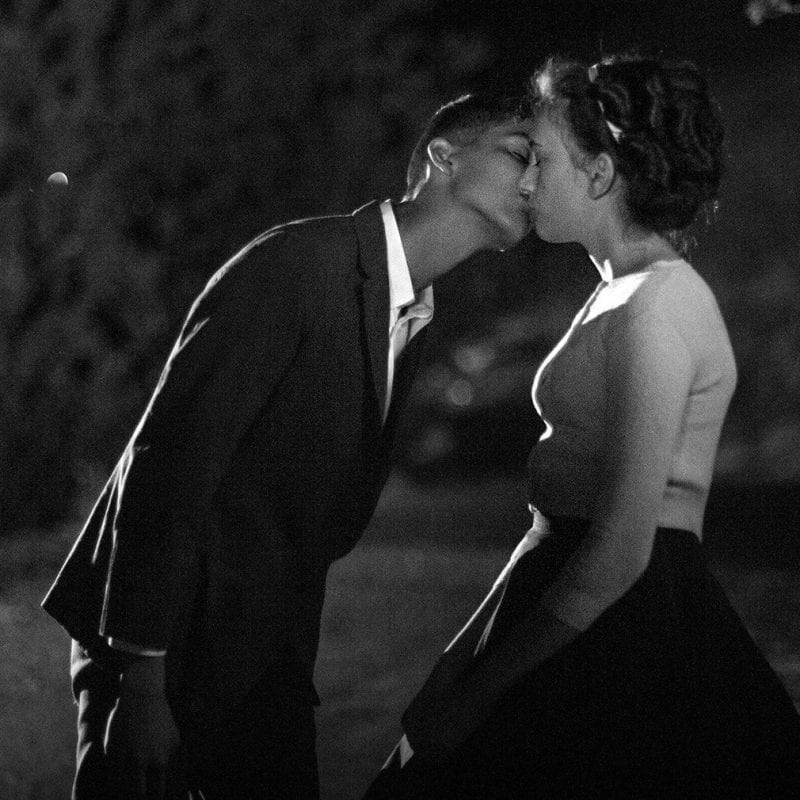
In the very moment when Sarah killed “Truck You”-dude, she was the flock of lionesses that killed the black bull – just as in the TV documentary she had watched at home. It’s all gutwrenchingly savage, but it’s about survival. Sarah, already standing on the edge of the peaks, wasn’t going to let a misogynist a**hole push her any further. She warned him, she even said “please”. Finally, she did what she thought necessary in order to survive mentally.
Sarah’s reactions and actions at the bar and on the floor with Laura’s photograph don’t make her evil. They make her appear just as vulnerable and desperate as the circumstances of her life have shaped into being. Still, she’s not a pitiful victim in her own mind. She is just painfully human in that way that is completely independent of time and of space.
Meanwhile…
Recommended further reading from the site:
Saving Sarah Palmer by Ali Sciarabba
The Gifted and the Damned – What’s eating Sarah Palmer by Eileen G. Mykkels
Black as a Fire – Twin Peaks is diseased and war is coming by Gisela Fleischer

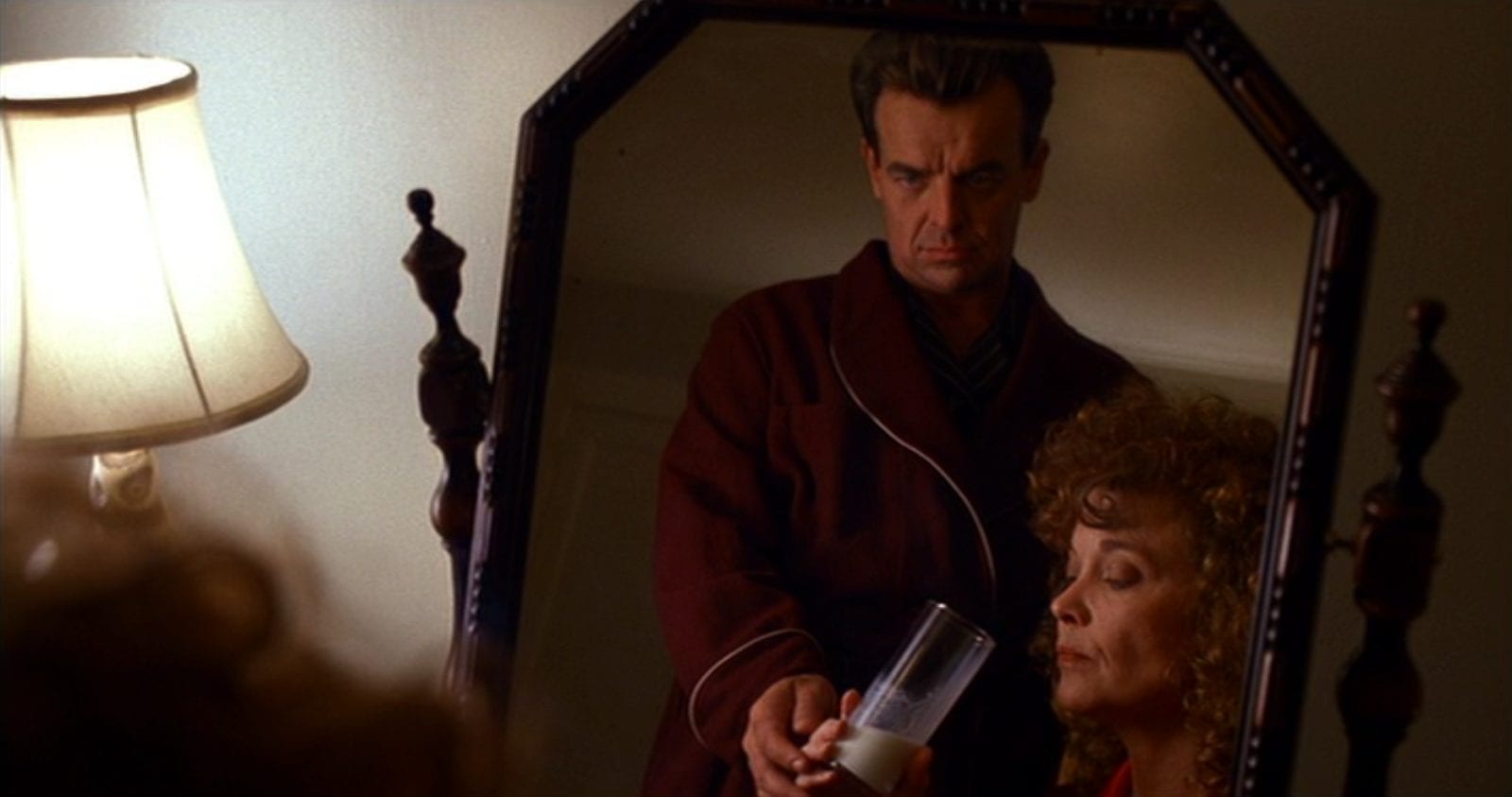
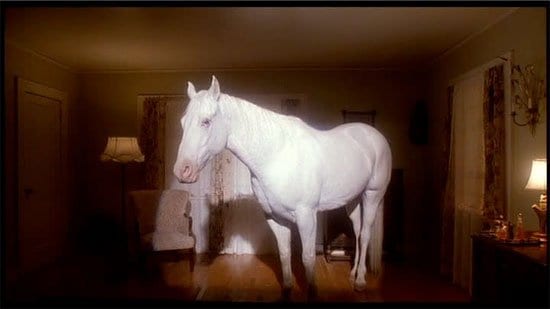

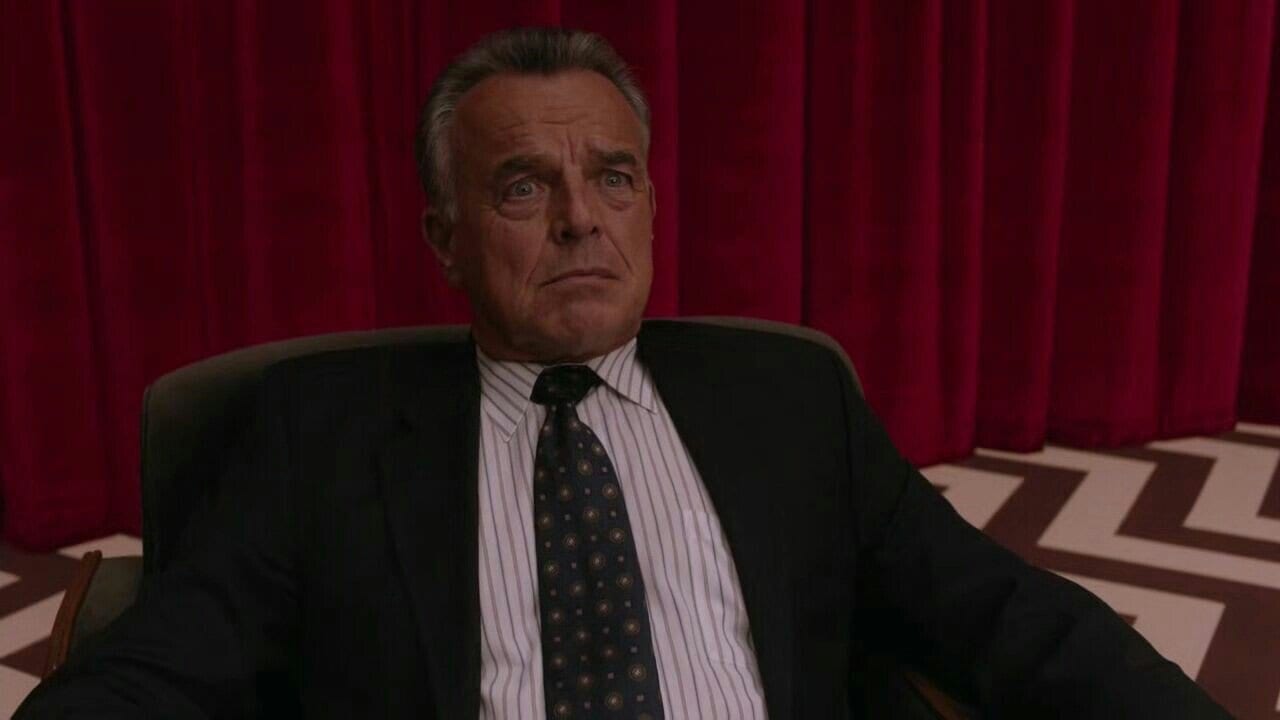
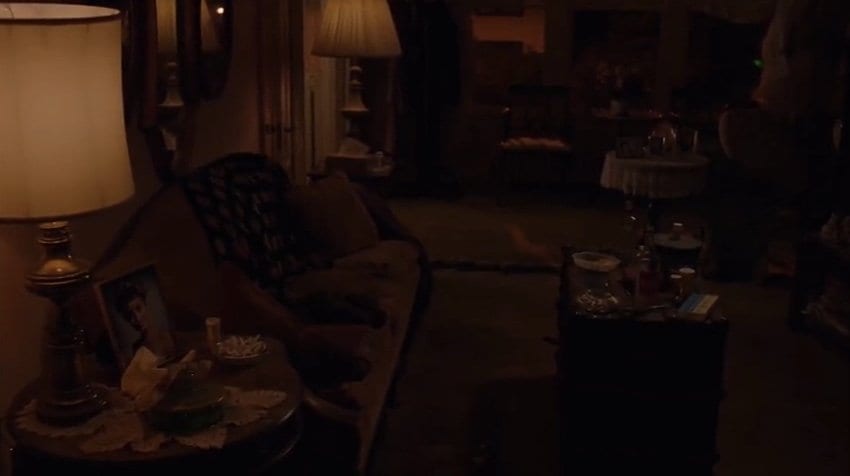
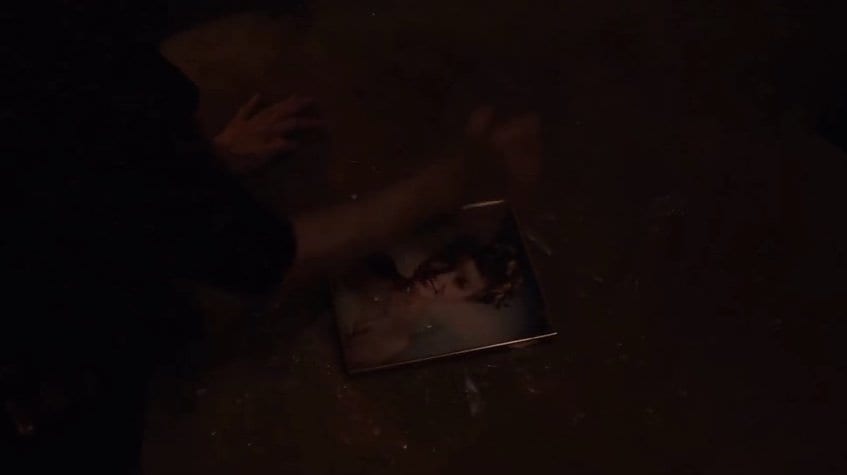
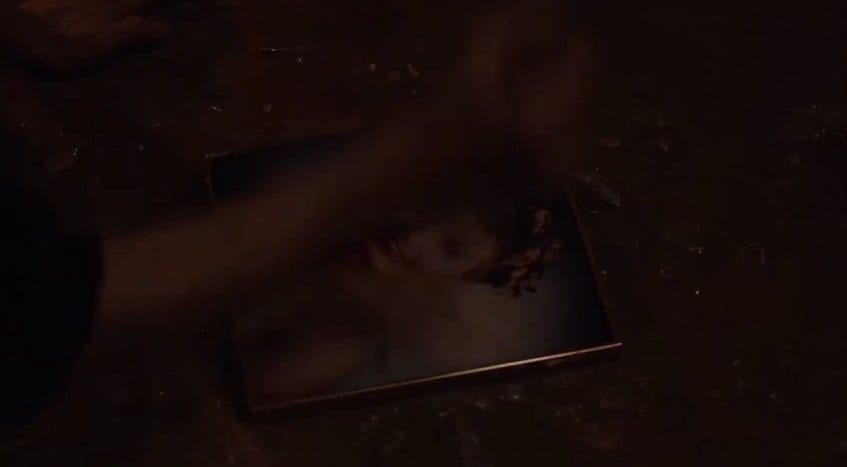
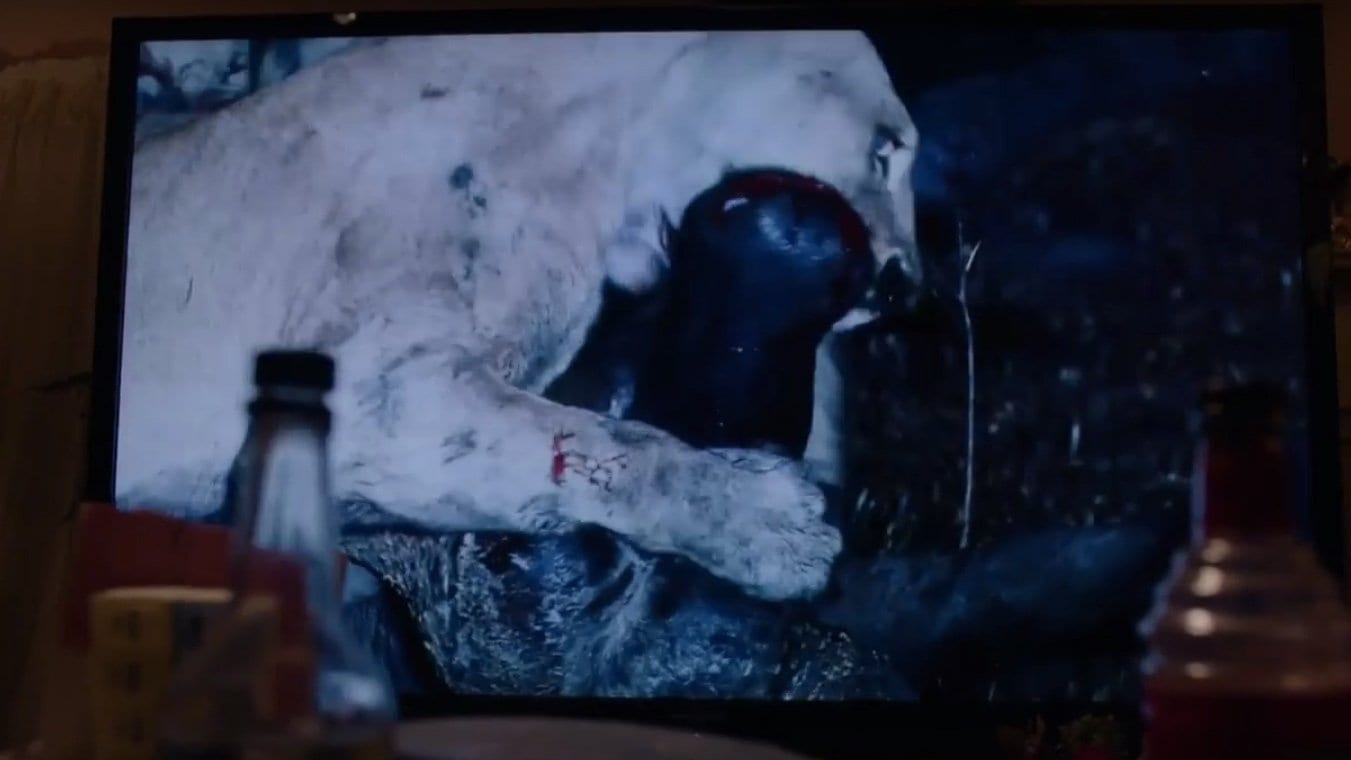

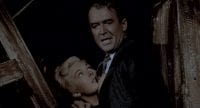
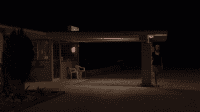

since we’re talking about the effect of someone going back in time to alter events, it sort of doesn’t matter where in the timeline we saw Sarah does any of these things. there’s a strong possibility that a lot of the Twin Peaks scenes were of people for whom Laura is missing and not dead. this is the first time i’ve even considered rewatching any of it but i wonder if anyone even mentions her as dead through the whole show. Bobby cries over her but that doesn’t mean he thinks she’s dead. Hawk is looking through her files but that doesn’t mean he’s looking at a murder investigation’s files. Maybe the missing thing Margaret is talking about is the change in Laura’s status. it seems like there are people who remember things the way we were but there are other people who could already be living the other timeline the whole time we were watching. Cooper hadn’t gone back yet in terms of what we were seeing but once he does, he was already there the whole time.
Thank you for your comment! I agree with much of what you point out. But. There is actually a mentioning of Laura being dead. It’s in part 7 when Hawk and Truman are looking at the theee pages that Hawk found in the bathroom stall door. Truman says: “Laura never met Cooper… He came here after she died?”
My thoughts exactly David. I thinks it’s a mistake to think of alternate/multiple timelines. Characters in the show (and in The Final Dossier) are actually seeing reality change before their very eyes.
I believe Frank Truman talks about the “death of a Laura Palmer.”
Great text. Just came across this and thought you might find this interview to Grace Zabriskie interesting (if you haven’t listened to it yet): https://www.youtube.com/watch?v=_RJjnzmH5bg
I think the show mixes both events: the one Laura died and the one Laura dissapeared. The line is so thin that we can’t solve all. For me, the town is more sick and wild than never before. So, we maybe see a lot of Laura dissapeared consecuences.
And ending with Carrie returning home would be an easy metaphor of Laura meeting again with her mother (after Laura dissapear not die). But Sarah is not there anymore. In fact, Judy is here more than Alice Tremond.
Conclusions: the past dictates the future, battle against Evil go on, past can’t be changed?
The end could be seen in a positive way or in sad one. Even in both ways. You choose.
Interesting read here! Very intuitive. It’s obviously left to viewer’s interpretation as to whether or not Sarah is Judy or is just a broken human with spiritual influences. However, I do believe one scene in particular is presenting a pretty solid case that Sarah is at least partially possessed by Judy in a similar manner to the way Bob possessed Leland…that is the grocery store flip out scene. It becomes very clear that, as Sarah changes composure after panicking, that some other entity has almost fully taken over and is convincing Sarah to “stop this” and leave the store, Sarah even mumbles those exact words. Most typical evil entities wouldn’t likely care how Sarah behaves in public, but this particular entity wanted to shut Sarah up, get her back to the house/nesting ground. That house is now a trap Judy is setting, perhaps to catch Laura (to possess her) when Cooper brings her back as Carrie in episode 18??? It is then Cooper who is in turn setting his own trap within Judy’s trap (two birds with one stone). At least for me, the possessor’s insistence on keeping the cover of Sarah normalized in the public’s eyes during the grocery store scene for some sinister agenda is pretty decent evidence that Sarah is heavily (not just lightly) under the influence of Judy. She may not be Judy, but Judy has certainly become her. She is still Sarah, like with Leland, but there were times when Judy took over almost fully. I do admit, your take on the elk bar left it somewhat open for me that it was either Judy or Sarah who killed the trucker, but I still believe Judy did the actual killing. Sarah just allowed it to happen, perhaps even an active accomplice, but something inside Sarah came out and clipped the guy’s throat, not Sarah. I do admit, the creepy living room picture stabbing scene could go either way, I neither agree nor disagree here. Just my takes, but your observations are all spot on. We just have slightly different interpretations! Thanks for the engaging discussion!
That was me who did the overlays of Laura’s smile on Sarah’s face hole ?
Reading your article, especially the line “It really is a world of truck drivers.” made me think of the scene where Mr. C knocks out the door man in Buela’s place, just before he leaves with Ray and Daria. He then tells her to put something better outside her door and Buela responds something to the effect of “it’s a world of truck drivers…”
I can’t ignore the Sarah Palmer / Mr. C parallel in this.
Interesting stuff.
Not that it matters much to your overall interpretation, but that’s clearly not Laura Palmer’s hand on Sarah’s black smoke face. As for the face in the Jumping Man scene, some people see Laura’s face, others see Sarah’s. Though I think Sarah’s face is more likely, I’m not entirely convinced.